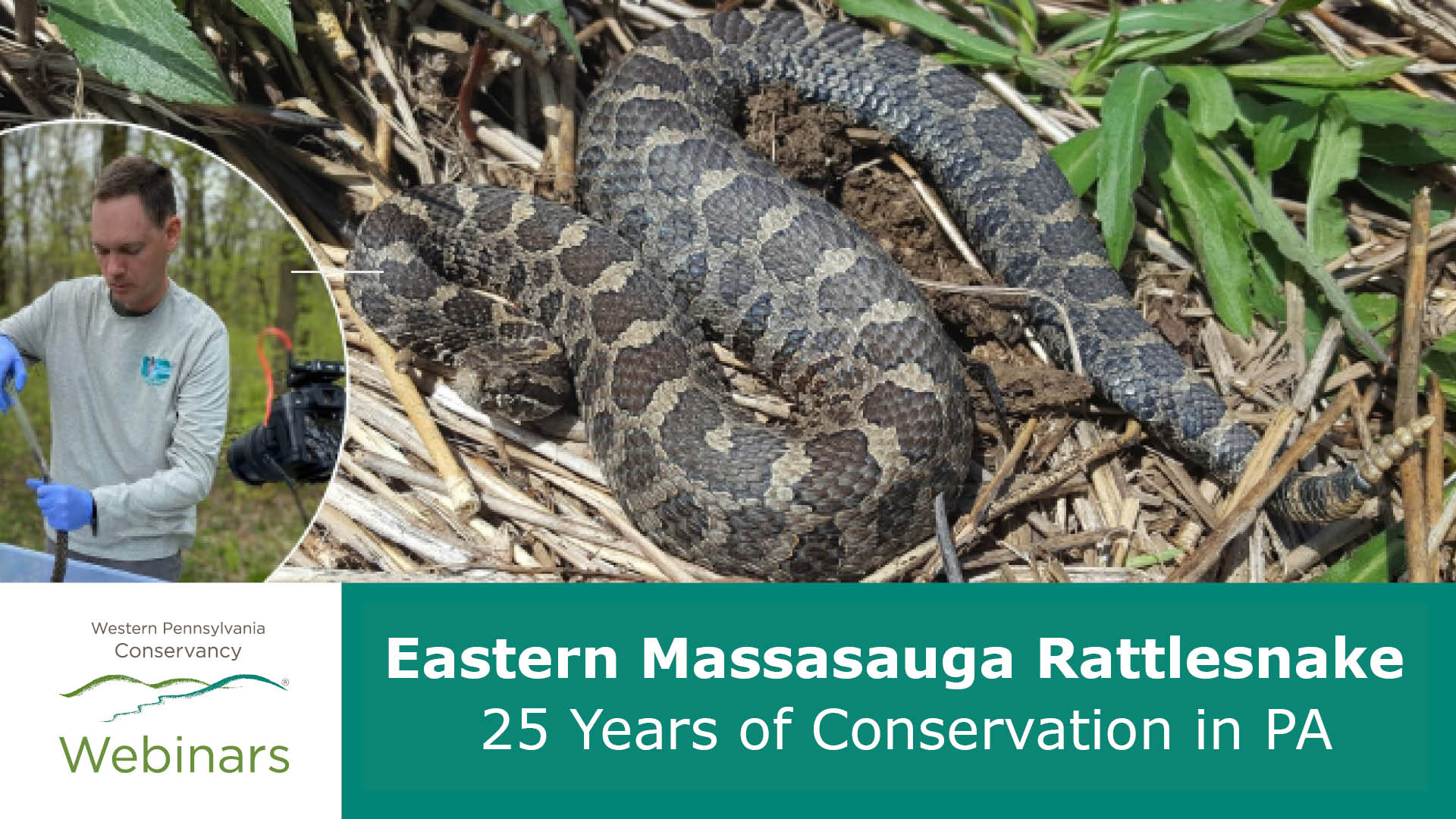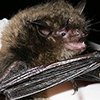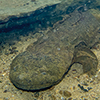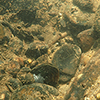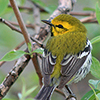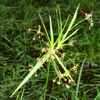Conservation Science
Protecting Pennsylvania's Plants and Animals
Species at Risk:
Eastern Massasauga Rattlesnake
Join us for a webinar on the
Eastern Massasauga Rattlesnake
July 17, 2025
12:00 pm ET
This small, stout rattlesnake is listed by the U.S. Fish and Wildlife Service as a federally threatened species. In Pennsylvania, only four of 19 historic populations still exist, making it a critically imperiled endangered species. Snakes, and specifically massasaugas, are a vital part of our ecosystem. The eastern massasauga (Sistrurus catenatus catenatus) is considered an “umbrella” species, meaning its protection in turn impacts other species sharing all or some of the same environmental requirements. The Western Pennsylvania Conservancy has been a leading partner in eastern massasauga conservation and research in the region.
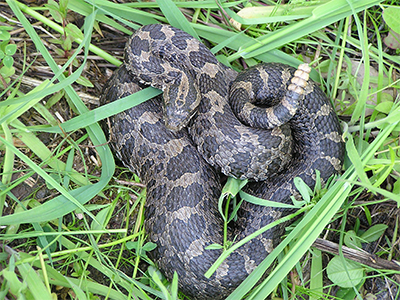
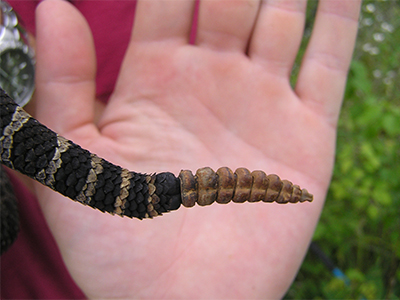
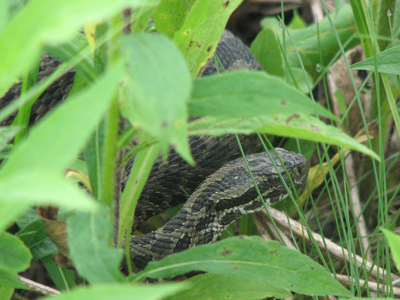
The eastern massasauga rattlesnake averages 20 to 30 inches in length. The snake is light gray with a color pattern that includes a series of large, dark brown and black, middorsal blotches and two to three rows of lateral blotches. Young rattlesnakes measure approximately nine inches long and have a yellow-tipped tail with a “button” rather than a fully-developed functioning rattle.
You might mistake the adult snake’s rattle for the buzz of an insect. In fact, the eastern massasauga’s rattle is barely audible beyond a distance of five feet. While massasaugas are venomous, they have a very mild-mannered temperament and rarely strike unless handled. Most massasaugas will rely on their camouflage and remain quiet and still when approached.
Habits and Habitat
Massasaugas utilize low-lying, poorly drained open habitats in the spring, fall and winter. They rely on crayfish burrows and other fissures to access ground water that remains unfrozen throughout the winter for hibernation. This habitat allows snakes to find refuge from the freezing Pennsylvania winters and retreat from predators in the spring and fall. After emerging from hibernation in April, the massasauga begins feeding on small rodents and sunning in lowland areas for about a month.
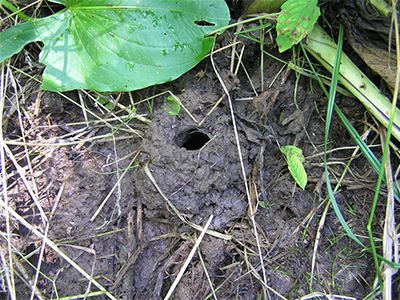 In late spring and summer, they move upland to nearby drier fields, prairies or meadows. During this time, males and non-pregnant females will spend the summer foraging. Breeding takes place in August and September. Pregnant females will choose sparsely vegetated dry areas to bask until they give birth to their young in August or early September. Females reach breeding age at four years and give birth to an average of six or seven young every other year. The average seasonal home range for the massasauga in Western Pennsylvania is 3.8 acres.
In late spring and summer, they move upland to nearby drier fields, prairies or meadows. During this time, males and non-pregnant females will spend the summer foraging. Breeding takes place in August and September. Pregnant females will choose sparsely vegetated dry areas to bask until they give birth to their young in August or early September. Females reach breeding age at four years and give birth to an average of six or seven young every other year. The average seasonal home range for the massasauga in Western Pennsylvania is 3.8 acres.
Many species, such as the massasauga, are uniquely important as indicators of environmental quality and function as “environmental monitors.” They also control the rodent population, thereby controlling rodent-carried diseases. Breakthroughs in the medical field have even resulted in medications for hypertension and diabetes from rattlesnake venom.
There are many direct and indirect benefits to conserving this species in Pennsylvania. Yet these docile and ecologically important creatures are in great jeopardy. Without immediate conservation of critical habitat for the massasauga, remaining populations may be lost in the near future.
Threats
The dramatic decline of the eastern massasauga is alarming. Since the early 1900s damming, road building, surface mining and urbanization have destroyed large amounts of Pennsylvania’s massasauga habitat. Since the massasauga requires open space, the habitat that remains is threatened by becoming overgrown by trees and shrubs.
Managing Massasauga Habitat
In general, massasauga habitat can be established and managed using a variety of practices, including the following:
- Brush clearing
- Carefully timed seasonal mowing
- Establishing/seeding prairie grasses, wildflowers and other native plants
- Prescribed burning
- Selective use of herbicides
Most of the management activities should occur during the massasauga’s hibernation period between November and March when the ground is frozen. Reclaimed massasauga habitat must be maintained periodically to keep forest encroachment in check. This may require management as often as every few years to as rarely as every 20 years, depending on the site.
Research
Inventory (2003-2005)
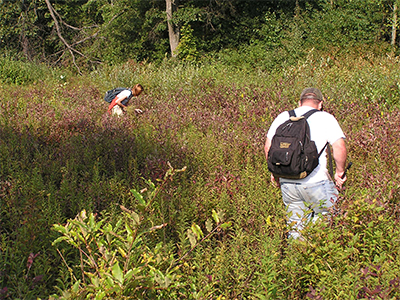 The Conservancy and the Pennsylvania Natural Heritage Program investigated the presence of the eastern massasauga at 63 locations in Western Pennsylvania where the snake was historically known to reside. Over the past century, the eastern massasauga has declined from 19 populations in six counties to only four isolated populations in Butler and Venango counties.
The Conservancy and the Pennsylvania Natural Heritage Program investigated the presence of the eastern massasauga at 63 locations in Western Pennsylvania where the snake was historically known to reside. Over the past century, the eastern massasauga has declined from 19 populations in six counties to only four isolated populations in Butler and Venango counties.
The results of the two-year inventory found only four locations with known massasauga populations. Nineteen locations provided doubtful evidence for the support of populations and 38 were considered extirpated. Two locations were believed to have been reported erroneously. The massasauga’s decline happened despite identification of contributing factors and state listing as an endangered species. Habitat loss, once caused most prominently by the destruction of wetlands, is now primarily caused by forest succession and is the main factor for modern-day population declines. If this habitat loss remains unchecked, it will likely result in the extirpation of the remaining populations.
Radio Telemetry (2005-2006)
As WPC considered ways to help conserve this species, an important piece of information was missing: the way that massasaugas use the habitat and the role that temperature plays in movement and hibernation.
 To better understand the ecology of these animals within specific locations in Pennsylvania, WPC undertook a study of movement of individual snakes over a two-year period. In all, 51 free-ranging individuals – 17 gravid (pregnant) females, 7 non-gravid females, 12 males and 15 juveniles – were equipped with temperature sensitive radio transmitters and monitored every 48 hours.
To better understand the ecology of these animals within specific locations in Pennsylvania, WPC undertook a study of movement of individual snakes over a two-year period. In all, 51 free-ranging individuals – 17 gravid (pregnant) females, 7 non-gravid females, 12 males and 15 juveniles – were equipped with temperature sensitive radio transmitters and monitored every 48 hours.
Through this study, WPC and PNHP concluded that adult massasaugas in Pennsylvania had a mean home range of 3.8 acres, and mean total distance moved over a season of 2,465 feet. Gravid females had smaller home ranges and movement parameters than males, non-gravid females and postpartum females. When tracked over the entire activity season, there was no significant difference in the home ranges or movements of snakes of different sexes or reproductive conditions.
We were also able to determine the massasauga’s seasonal movements and habitat preferences. Seasonal movements were characterized by a general tendency to remain in or near hibernacula in the spring. In the summer, the snake expanded its range and movement to surrounding areas of drier, upland habitat dominated by forbs and open canopy. In autumn, massasauga showed a gradual return to the hibernacula, with a preference for areas with forbs and open canopy. Gravid females showed a particular preference for dry areas of very low vegetation, often in proximity to shrubs.
Fields of forbs and low-growing grasses with an open canopy and spotty distribution of woody shrubs characterize the habitat of the massasauga in Pennsylvania. Habitat is consistently found in proximity to wetland soils. Snakes of different age and fitness respond to subtle differences in micro-habitat that meet their individual needs and this is true throughout their life histories.
WPC Zoologist Ryan Miller explains how the Western Pennsylvania Conservancy protects the endangered
eastern massasauga rattlesnake through research and PIT tagging (micro-chipping).
Population Monitoring and Habitat Restoration (2007-Present)
Since the conclusion of comprehensive research studies, WPC has continued to work with federal, state, and private partners to monitor the remaining populations of the massasauga in Western Pennsylvania. This monitoring includes occasionally surveying the populations, PIT tagging individual snakes encountered during surveys, and monitoring the snake’s use of newly managed habitats. WPC consults with land managers and private landowners about the status of the snakes on their properties and advocates for continued maintenance and protection of massasaugas and their habitat. Continue reading to learn about our efforts to stop the loss of massasauga habitat.
Conservation, Habitat Planning
and Management
Information gathered from our studies provided the framework for a comprehensive conservation and management plan for the eastern massasauga, which includes habitat management recommendations. This plan was submitted to the Pennsylvania Fish and Boat Commission, which is the jurisdictional agency for the species, and is being used to guide conservation work for the massasauga in Pennsylvania.
WPC has implemented habitat management recommendations on private lands where the massasauga and its preferred habitat are being threatened by woody vegetation succession. With the support from and cooperation of private landowners and private foundations, WPC has managed and restored approximately 70 acres of habitat.
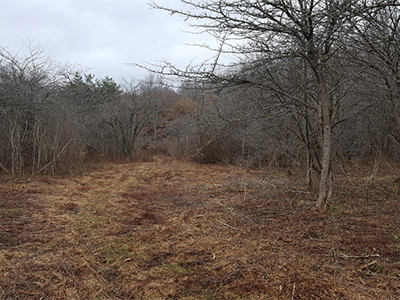
Before habitat restoration
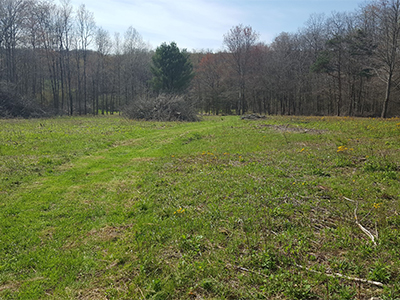
After habitat restoration
What Can You Do?
It’s possible that land you own provides suitable habitat for the eastern massasauga. There are many sustainable ways to enjoy your land while simultaneously protecting massasauga habitat.
- Floral – Depending on your habitat plan for your property, grasslands or meadows can be planned to provide a colorful, vibrant backdrop for you to enjoy. These grasslands and meadows may contain beautiful wildflowers that attract songbirds in the spring and summer.
- Agricultural – Many agricultural activities, if conducted in a sustainable manner, will not negatively affect the massasauga and its critical habitat. Sustainable agricultural activities can be conducted in accordance with a soil conservation plan that minimizes adverse effects on wildlife.
- Hunting – Massasauga habitat is utilized by many game species. It is not uncommon to find deer, turkey, grouse, woodcock and rabbits in the grass and underbrush of massasauga habitat.
For more information, download the brochure “A Landowner’s Guide to the Eastern Massasauga in Pennsylvania: Management & Protection.”

Conservation Easements
One way to permanently preserve massasauga habitat, while keeping the property in private ownership, is through a conservation easement. A conservation easement is a voluntary legal agreement between the landowner and a land trust, such as the Western Pennsylvania Conservancy, that limits uses of the land in order to protect its conservation values, such as the conservation of critical massasauga habitat. Every easement is tailored to the property and to the interests of the landowner. Typically, with a donation of conservation easements the landowner realizes a significant income tax deduction.
The drastic decline of the massasauga is alarming, but you can make a lasting difference by helping us protect them. If you own land with suitable habitat for massasauga in Pennsylvania and are interested in protection and/or management for the species, please contact Matt Marusiak at 814-776-1114 or mmarusiak@paconserve.org for more information.
For More Information:
Western Pennsylvania Conservancy
800 Waterfront Drive
Pittsburgh, PA 15222
412-288-2777
Pennsylvania Fish and Boat Commission
Division of Habitat Management

